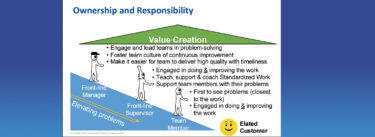LEI Founder Jim Womack shared his thoughts on the need for constancy of purpose in any enduring lean transformation in this 2009 letter, which we are republishing as part of our series exploring purposeful enterprise. In his book Gemba Walks, Jim noted that: “It turns out that even the most able transformational leaders need more than the five years we had allotted to complete a lean transformation. It follows that sticking to it is a critical element of success…Getting the right thing done—whatever it might be—through constancy of management focus is critical to a lean transformation.”
The first of Dr. W. Edwards Deming’s 14 Points is “create constancy of purpose for continual improvement of products and service to society.” When I first read this many years ago it seemed so simple and obvious. How could anyone not have constancy of purpose?
Now that I’m older and wiser, or at least older, I have discovered that this simple attitude is often the missing element when managers set out to create a lean enterprise. Organizations start with the best intentions, launch a lean program, gain some initial results, lose their focus (perhaps as a result of an economic crisis?), and backslide to their original state of performance. They then set off again with the best intentions…
The power of constancy of purpose hit me with particular force recently when I visited a firm that started its lean journey fourteen years ago and has truly practiced Deming’s first point. I found the story so compelling that I would like to share it.
It’s about Bob and Ed although these are not their real names. (They have requested that I not identify them for fear of being overwhelmed with lean tourists.) In June of 1995 Bob approached me at a conference I had organized and announced emphatically that he was going to create a true lean enterprise. Because I had heard this statement of good intentions many times before and because Bob was only a plant manager in a large firm with many plants, I told him frankly that I doubted he would get anywhere. But I pointed out a few other people at the conference he might talk to if he needed specific advice on how to get going. And I never expected to hear from him again.
About two months later Bob called to announce that he and his controller Ed had gotten started in their plant and that they wished me to inspect what they were doing. Then they wanted me to give a pep talk at a company-wide operations event for all plant managers as their first step in spreading the word.
I went with some trepidation. There is nothing more awkward than visiting eager managers in the first flush of lean enlightenment who need to hear how little they have actually done and how far they need to go.
But at least I was not disappointed with the opportunities at hand. Their massive facility was organized in process villages for all fabrication activities. An inaccurate MRP scheduled all operations, there were turnbacks everywhere for rework (not planned by the MRP), there was no visible standard work, and there were large inventories between each processing and assembly step. The facility had approximately .5S (as opposed to 5S), the primary workforce was disengaged, and the management team below Bob and Ed was firefighting with no focus on the big issues. The predictable result was long lead times, poor on-time performance to customer schedules, costs much higher than necessary, and a company in financial distress. In sum, everything that could be wrong was wrong with the exception of a few model areas where Bob and Ed had tried their first experiments.
Intensity, Focus, and Tenacity at the Gemba
The one thing the plant did have going for it was Bob and Ed’s constancy of purpose. As I walked through the operation, I quickly realized that I had been wrong at the conference. As I met the team they had formed, saw the boldness of their initial experiments, and felt their extraordinary intensity, focus, and tenacity on the gemba, I knew they would get somewhere and that it would be worth my while to observe. So I have been back four times over the years to check on their progress.
What did they do? Their first step over the first four years was to identify the basic product-family value streams and to create flow by removing unnecessary steps and lining up the remaining steps adjacent to each other in process sequence.
They needed to create basic stability by making each step both capable (in terms of good quality every time) and available (in the sense that every piece of technology was able to run when it needed to run to support flow in the process.)
As they did this they soon learned that they needed to create basic stability by making each step both capable (in terms of good quality every time) and availabl (in the sense that every piece of technology was able to run when it needed to run to support flow in the process.) Achieving this by introducing rigorous standard work, quality at the source, and a plan for every machine was their second step, pursued as Bob and Ed were being promoted to Operations and Improvement leaders for all of the firm’s facilities.
Four years into their transformation (which was already much longer than most lean journeys last), Bob and Ed were ready for a dramatic third step, which was to introduce rigorous strategy deployment at every level of the company and, as a fourth step, to reorganize the entire $1 billion business into a number of value-stream business units with dedicated engineers, production teams, purchasing, etc.
(Today their strategy deployment process is the most rigorous and comprehensive I have seen. As I recently talked with those working on this year’s strategy deployment in different streams, I realized again that if strategy deployment isn’t driving you crazy, you aren’t doing strategy deployment. This is because the whole idea is to flush out for resolution the contradictions and conflicts between value streams and functions that remain well hidden in most organizations.)
New Challenges Deploying Strategy
As the organization rolled out strategy deployment, the focus on standard work was redoubled and a rapid problem resolution process was instituted. (Together these steps, with slightly different names, constitute the three key lean management techniques we advocate at LEI: Policy management cascading from the top to set direction and gain alignment. A3 analysis to deploy policy initiatives from above, resolve problems, and evaluate proposals from below. And standard work with standard management to sustain capability and availability.)
The two final steps in creating a lean enterprise were to transform the product and process development process to incorporate lean principles and to convert a very conventional purchasing organization into a lean supply management team. The last step is just being completed after a fourteen-year journey.
With the complete lean business system now in place, the current challenge facing the management team is to globalize operations and the supply stream. Their objective is to better support customers around the world without losing the hard won line-of-sight ability to deal with problems in real time.
A final challenge lies not far ahead – one few organizations have faced. How can Bob, now the President, and Ed, now the Vice President for Operations and Improvement, hand off the lean journey to the next generation of management as they approach retirement age?
Bob and Ed’s journey is inspiring. Indeed, as I look at the last fourteen years, I ask what would have happened to the world economy if every plant manager and controller had had their constancy of purpose to completely transform an entire management and business system. What if by doing this every manager in every firm had increased labor productivity nearly six fold, cut the needed space per unit of output by 75%, achieved nearly perfect quality with 100% on-time delivery to customers, steadily improved margins, and rapidly grown sales? We would be living in a very different and much better world. So following their path must be the challenge for the rest of us.
As we set off, I need to emphasize one additional point, perhaps the most important. Bob and Ed started their journey in the trough of a major recession in their industry. As their firm struggled to fund development programs in 1997 it was acquired by a giant firm completely unaware of what they were doing and managed on different principles. Most managers would have been completely distracted – like most managers today at this traumatic point in history? They would have lost their concentration, just trying to get through the day under new ownership. But these managers had set a course and they sailed steadily ahead through some very rough seas. This is the real challenge for all of us now — to seize the current crisis, set a steady course, and turn today’s chaos to a useful end.





